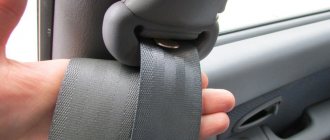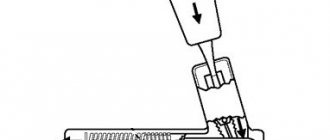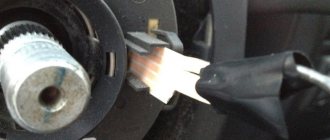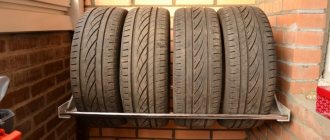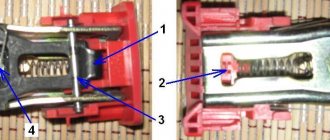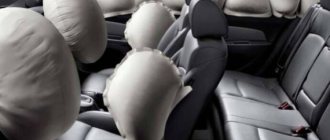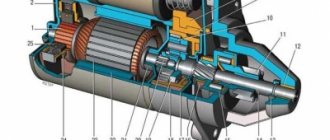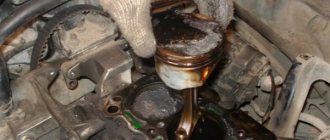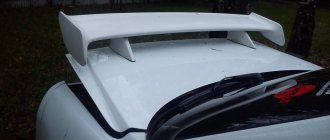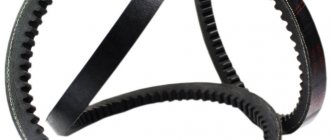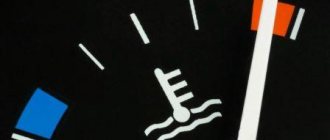How to reassemble a car seat after washing? This is worth thinking about before you start cleaning or washing the seat cover, which ensures the safety of the baby who is in the car while driving. The special design allows the cover to be washed multiple times without damaging it. The visual appeal and integrity of the material can be preserved by proper washing using appropriate detergents. Assembling the car seat in compliance with all the recommendations given in the instructions makes it possible to avoid damage to the fabric and breakage of individual structural elements.
How to install a child seat in a car - video instructions
Publication date: February 15, 2021.
Category: Automotive equipment. A car child seat is not a design element of the car interior and is not a comfortable seat for a child. Today, having a car seat is mandatory if you are transporting children under 12 years of age, otherwise a fine of 3,000 rubles will be imposed on the car owner. Such requirements appeared for a reason; they are dictated by inexorable statistics, which clearly reflect the data according to which the presence of a child seat in a car can actually save the baby’s life.
But it’s not enough to just buy a seat; you need to take into account the age, weight and height of the child. And also ask the seller how to secure the child seat in the car. Today there are two methods of such fastening: with standard three-point belts or using the Isofix system.
Actions before cleaning
Before assembling a child seat for a car after washing, you need to familiarize yourself with the design features and remove the cover without damaging individual small parts and fasteners.
During operation, a large amount of dust accumulates on the surface of soft parts and belts and other contaminants appear. This can cause an allergic reaction in the baby.
Removing the case and straps is quite simple, but returning all the components to their places is not always possible. Therefore, some parents refuse to wash and are content with only superficial wet cleaning. However, such treatment is not enough to eliminate severe contamination and maintain the health of the little user at the proper level.
Before washing, you should carefully study the instructions, which provide clear instructions and describe the procedure for:
Some manufacturers do not care about the presence of this description, and therefore parents should write down or take step-by-step photographs before the first wash to remember the sequence of attaching individual parts. It is important to return all components to their previous position in strict sequence, otherwise there will be no reliable fixation of the small passenger in the seat for transporting him.
Options for attaching a child seat in a car
Let's consider universal and more “advanced” methods of securing a seat in a car:
Fastening with standard belts
Since every car is equipped with seat belts, this method is considered the simplest and most convenient. In fact, everything is not so simple, because this procedure has several disadvantages. Firstly, it is not considered the most reliable. Secondly, when installing a category 0 seat, the belts may not be long enough.
Important! If the length of the car belts is not enough to securely fix the child seat, it is not recommended to extend the belts yourself. It is better to contact a car dealer or service department to have specialists replace this element.
For fastening with standard products, make sure that there are marks on the seat body where the belts pass (red if the seat is intended for forward-facing installation, blue for rear-facing installation). At the same time, do not forget about the mounted fastening elements (internal five-point belts). Typically, only products of categories 0, 0+ and 1 are equipped with such parts. Child seats of groups 2 and 3 do not have such elements, so it is important to make sure that the child seat is secured in the car with high-quality standard belts.
Fastening via Isofix system
The Isofix system has a standard design, so it will fit any brand of seat. Thanks to the locks on the seat and special steel hinges installed in the vehicle, the most reliable fixation of the car seat is carried out. Compared with the previous method, according to studies, when fastening with conventional seat belts, more than 60% of users make mistakes. In the case of Isofix, such shortcomings are reduced to almost zero.
It is worth noting that reliable brackets can be placed between the cushion and backrest of both the rear and front passenger seats. In addition, the locks are easy to unlatch when you want to remove the category 0 seat, which is designed as a carrycot.
Important! Installing a child seat in the front seat is not recommended by experts, since the passenger seat is considered one of the most dangerous in a car.
Since this system only secures the lower part of the car seat, it is recommended to use an anchor belt to further protect the child from “nodding”.
Other fastening methods
Today there is also a “base” mounting option, which is considered one of the most convenient and reliable for the age group 0+. The fastener is based on a special platform that cannot be removed from the car and is secured either through Isofix or using standard belts. The base is fixed with fasteners and clamps.
There is an American analogue Super Latch system, which allows you to secure the chair with special belts and brackets, but it has now been abandoned in Europe.
As for the direction of the seat and other nuances, there are rules here too.
Removing the seat belts
- Loosen the seat belt tension.
- Remove the shoulder straps and shoulder pad straps from the connecting brackets as shown in the illustration.
- Pull the shoulder straps out of the corresponding holes in the backrest and then out of the holes located on the bottom of the car seat.
- Recline the car seat to the maximum angle (position 4). At the front, under the seat, you will see a metal buckle that prevents the center strap from jumping out.
- Pass the buckle sideways through the holes as shown in the picture to remove the straps.
Fixing the car seat depending on the seat category
In order to secure the chair according to all the rules, it is necessary to take into account the age of the child and the category of the purchased chair. The safest place, from a parent’s point of view, is not always the right one, so in order not to make a mistake, remember:
- Category 0 seats (cradles for small children) can only be installed in the back seat, with the head of the car facing away from the doors. In this case, the cradle should be located perpendicular to the movement of the car.
- Products of group 0+ can also be installed exclusively in the back seat, only in this case the child must sit facing the direction of the vehicle. Car seats 0+ can be located in the front, but only if there is no airbag in this place.
Important! In combination category 0+/1 seats, the seat belt must be fastened below the child's shoulder.
- Category 1 seats are rear mounted, although front mounting is also possible. In both cases, the child should sit in the direction of travel. A prerequisite is the presence of an internal five-point belt. The main belt in this case is located just above the child’s shoulder level.
- Group 2 child seats are installed in both the rear and front seats. In this case, the child is positioned facing the direction of movement. The belt should pass through the center of the young passenger's shoulder.
- Category 3 seats (boosters) do not have side walls and backrests. Such products can be mounted both front and rear. The child travels in the direction of the car.
In addition to these nuances, there are also general recommendations and useful tips for installing child car seats.
How to install a child car seat correctly
As mentioned earlier, many parents do not install the car seat for their child correctly, to avoid these shortcomings follow a few tips:
- Study the instructions included with the child seat in detail, as the method of installation may differ depending on the model of the product.
- The most reliable place to install the seat is considered to be the middle place in the rear seat.
- Before installing the chair, move the front seat back so that it does not interfere with your work.
- Once you have placed the car seat in the back seat, route the seat belt over the designated area. At the same time, do not be afraid to apply maximum force when tightening the belts. If the seat is equipped with special clamps this will greatly simplify this procedure. Some seat belts have removable clips. If they are, then you can simply pull the belt out to its full length, snap it, when it comes back, it will fasten itself. If there are no such clamps, use connecting elements.
- After fixing, you need to make sure that the belt is securely fastened in the shoulder area, while its waist part will be responsible for fixing the chair.
- During installation, make sure that the seat belt receptacle does not come into contact with parts or components of the child seat.
- Take the time to adjust the height of the OEM belt guide. If this element is located too high, then in the event of an accident or a sharp jerk of the car, it can squeeze the child’s neck.
- After installation, move the chair in different directions; if it “plays” a little, this is normal. But, if the seat moves more than 2 centimeters, then the product must be removed and reinstalled.
- Place your child in the car seat and fasten all the seat belts. The space between the belts and the body of the young passenger should be small, no more than 2 fingers.
- If after each use of the chair you take it home, then each subsequent installation should be done with the utmost care. And if the seat is in the car all the time, then still check all the fasteners before the trip.
And the last thing you need to pay attention to constantly is that the belts should never get twisted or tangled.
Possible problems and their solutions
Often mistakes and problems happen after the first cleaning of the car seat. If any difficulty arises, you need to know how to resolve it. Let's look at the most common situations.
Incorrect assembly of the car seat
To understand what exactly was done incorrectly and how it can be corrected, you need to carefully read each point of the instructions again and check all the actions performed. It’s even better if you have the opportunity to watch video instructions - sometimes it’s enough to see how to do it once to understand your mistake. Under no circumstances should you use an incorrectly assembled seat - this can lead to child injury, even when driving quietly in a car.
The straps are located inconveniently
It is clear that the seat belts are located at the level of the baby’s shoulders. The inconvenience may consist in their tension being too strong or, conversely, they do not stay in place. Most likely they are not connected correctly. It is necessary to check all connections again and adjust the degree of tension of the belts for the child.
The child is uncomfortable sitting in the chair
This defect may also be due to improper assembly, especially if the child did not complain before cleaning. In this case, you also need to disassemble the chair and reassemble it, following the instructions exactly.
Child takes off seat belts
According to established rules, the locking device must be such that the child cannot open it independently. If it does this, it means the straps are not fastened correctly or are too loose.
The covers are deformed
If this happens, it means that the product was washed using the wrong program. If the deformation is very severe and hard folds form, you will most likely have to purchase a new cover - the child will not be able to sit comfortably on the crumpled material. You can, of course, try to use the chair without covers, but then all the dirt will quickly penetrate inside and it will not be so easy to wash them off.
Reassembling the car seat after washing is not difficult if you do it carefully and slowly, following all the steps and securing all the elements correctly.
The article was published in the Household section
Peculiarities
Among the wide range of child seats for a car, it can be quite difficult to find the “right”, suitable option. This is due to the fact that all existing modifications of the product have a number of features. It is these nuances and characteristics that distinguish seats of various categories and manufacturers from each other. They also allow you to determine the degree of safety of the structure. Among the most important features of car child seats, the following points should be highlighted:
- device type;
- types of fastening;
- existing installation versions;
- additional options.
Of course, it is necessary to describe these characteristics of the device under discussion in as much detail as possible. After all, the choice, as well as the well-being, health and life of children and their parents, depends on the correct understanding of this issue. The above features are interconnected with each other. Besides everything else, they all flow from each other. So, the type of chair largely determines all other criteria.
The type of product being described is currently determined based on two main criteria: the age and body weight of the child. It is these aspects that influence the choice of fastening method, shape, and design features of the seat. They also determine the principle of attachment to the vehicle interior.
The modern industry has already managed to divide into categories all the current models of this car accessory. Sellers identify several main groups.
- Category "0". These models carry the smallest passengers. They ensure maximum safety for the baby. The ability to transport the baby while asleep is also important. These models are used only on the rear seats. They are installed facing the direction of traffic.
- Category "0+". Suitable for babies aged from one to one and a half years. These models should carry small passengers weighing up to thirteen kilograms. The kit of such systems may include additional fastening elements and special supports.
- Category "1". Helps in transporting children from one to four years old weighing from nine to twenty kilograms. Products of this type can be installed facing the direction of movement.
- Categories "2" and "3" . Designed for travel by older children. Their body weight should be between eighteen and thirty-five kilograms.
- Booster. This category of products can be used when transporting older children. The design of the seat allows the existing safety elements to lie correctly. It also provides a sufficient degree of comfort and freedom for the child. The idea behind this option is to raise the child to a level where using a standard safety system is possible.
The first two options are popularly called infant carriers. The name comes from the fact that these models provide a half-lying position of the body. The child is secured using elastic straps and soft pads in a much more serious way than using alternative methods.
The remaining variations are most often released as transformers. You can change the height of the backrest. It is also possible to make changes to other design elements.
A universal model would be an excellent option for transporting children. This type of product is used for many years of a child’s life, from early childhood until adulthood. The range of body weight in such models varies from nine to thirty-five kilograms. These versions are equipped with an expanded system for adjusting the child’s growth. The choice of one or another seat model determines the degree of comfort and safety during the trip.
Possible problems
Unfortunately, owners are not always able to assemble the chair correctly. But the difficulties that arise can be easily resolved.
The product is not assembled correctly
Most often, problems arise because the owner has forgotten in what order and which parts need to be attached.
This happens when the owner has to assemble the chair for the first time. To prevent this from happening in the future, it is recommended that before disassembling the chair, you record each stage in detail with a description of the parts, their location and the sequence of their removal.
If the owner has similar materials on hand, especially with photos, this will allow him to significantly speed up the process of assembling the car seat. If it so happens that it has already been disassembled, and parents cannot remember how to reassemble the child seat after washing, then you should refer to the instructions. If it is not available or it does not help much, then you can use the help of friends who have more experience, or invite a specialist.
Inconvenient placement of belts
Sometimes, after assembling the chair, it turns out that the seat belts are not very comfortable. They can hang on the body or press with great force. In this case, the position of the seat belts should be changed. As a result, they should exit the chair at the level of the child's shoulder, and not from behind his back. But sometimes the problem can be caused by the fact that the child has already become old enough and needs a new chair. If this option is not suitable for parents, then you can get out of such a difficult situation by pulling out the lining. Due to this, the child will have more space.
Mounting methods: pros and cons
The general rule: it is advisable to fasten or secure the car seat in the middle of the rear seat, the child should sit facing forward (does not apply to models for newborns). Currently, the model range of the product under discussion is quite extensive. The entire set of car seats differs not only in colors and sizes, but also in mounting methods. A certain system of approaches and views has also developed on this issue. Currently, the mounting methods presented below are used.
The most popular system for securing children when transported in personal transport. This option is designed to fix the seat to the body in the rear of the car. Fastening is done using special carbines. Stainless steel is used in the manufacture of the product. Direct connection to the vehicle body helps prevent ruptures of structural elements and injury to the passenger. Another positive side of this option is its ease of use. To install, all you need to do is push the chair into the grooves until it stops. This option is characterized by increased reliability.
The lack of necessary fastening elements in some vehicles can be identified as disadvantages. This means that such a seat can not be installed in every car.
Latch or Super Latch
Here everything happens the same as in the previous version. The difference is that a different type of strap is used. In the domestic open spaces, this option has not gained due popularity.
Seat belts
Universal fastening method. In this case, there must be special grooves on the child seat. There is no general design requirement for such devices. So in this case, you should rely on the instructions supplied with the accessory. A well-known negative feature of the belt model can be considered the noticeable complexity of the installation process. There are also some differences in the geometry of a car seat and a car seat. This may cause inconvenience to all vehicle occupants.
The methods of securing seats described above are quite sufficient to ensure a standard level of safety. However, in addition to them, other options may be used. Most often it is an anchor strap or support.
Anchor strap
Special additional fastening. It protects the structure from possible displacement during heavy braking. By the way, the easiest thing to attach to a car sofa is an anchor product. You can do this yourself in just a few movements.
Despite the obvious positive aspects, this type of fastening has a serious disadvantage. The passenger's body weight must not exceed eighteen kilograms. If this rule is not followed, the system may not work!
Instead of a belt tape, a stand can be used - a support. It rests on the floor of the car and prevents the structure from moving. The support can be called a trustworthy method of fixing the chair. However, the need to install it may require additional material and time costs.
The choice of one type of fastening or another is determined by the potential capabilities of the passenger and the vehicle.
Care and maintenance
Removing the car seat cover
- Remove the padding and the car seat's own harness, including the leg divider.
- The cover can now be removed. To put on the cover, repeat all removal steps in reverse order.
Attention! The child restraint should not be used without a cover. Do not replace the child restraint cover with one not approved by the manufacturer.
- Wash the cover only by hand at a temperature not exceeding 30°C
- Do not use caustic or aggressive detergents
- Do not bleach
- Don't push
- Don't iron
- It is recommended to dry in the shade
- Wipe plastic parts with a damp cloth and soap.
How to position?
You have already purchased a car and a child seat. Now all that remains is to understand where in the vehicle the purchase should be installed. There are several options in this matter, but research and long experience lead to the results described below. Active users of the car devices under discussion know that you should not place a child in the front passenger seat. However, the actual arguments differ slightly from the generally accepted versions. The point is not at all that in this position a mass of windshield fragments will fly towards the child. And it’s not that the impact force will be excessive.
In fact, the airbag is to blame. It will save an adult passenger from certain death. It can seriously harm the child. If the desire to be with the baby is great, then you can simply refuse to use the airbag. In this case, you should rely on a strong body and special sides of the child seat. The most common variation is the location of the structure in the rear of the car on the sofa for passengers. Expert opinions agree on the need to install the device in the middle passenger's seat. This will reduce the negative impact on the child during a collision with the side of the car.
Another good alternative is to secure the chair on the second row of seats on the right. In this position, the risk of being hit by shrapnel is reduced to a minimum. Also, the child will always be under supervision, it will be easier to monitor him. In this case, you can increase the useful space: you just need to move the front passenger seat. In this case, the danger lies in the nearby door and structural parts of the car.
Tips for parents
Many young parents experience real panic when they are faced with the need to wash a car seat. And this is not surprising, since when purchasing this accessory, the seat is installed in the car in assembled form, while adults rarely bother to read the operating instructions. After all, many simply do not have enough knowledge to understand the information presented in them. As a result, this leads to the fact that, having failed to find the answer to their question in the instructions, parents begin to scold the manufacturer, accusing him of the fact that the chair turned out to be disposable.
But in fact, everything can be fixed. There are many tricks for cleaning a chair without even having to remove the cover. A positive result can be achieved using such proven products as a hypoallergenic stain remover, a sponge and a solution with soapy water. They will do an excellent job of removing stains from seat belts and will relieve parents of many difficulties.
There are situations when the child's seat needs more serious cleaning. In this case, you will have to work hard and disassemble the chair. To avoid problems, it is recommended that you first carefully inspect your existing model. The covers of most chairs can be removed without any problems.
In most cases, seat belts are attached at 5 points, guaranteeing the maximum level of protection for the child. Therefore, you must first find a bright button in the center of the belt connection, which will help you quickly disassemble. The fastening straps can be loosened using a deep button, which can be found on the front of the chair. After pressing it, just pull the straps towards you, after which they will immediately loosen.
How and where to properly install a child seat in a car
Good day to all! It is hardly worth arguing with the fact that the safety of children in the car plays a huge role. And it is very strange to observe situations when a small child sits in a regular seat. It's even worse where it is in the arms of the passenger sitting in front.
To protect children from possible injuries when traveling in a car, there are special car seats. And today we will discuss how to install a child seat, what you need to know about this procedure and what features the installation has depending on the weight and age of our children.
I advise you to approach this issue very responsibly. Only correct installation will achieve the desired effect. And violating the placement rules can only make the situation worse.
Height of shoulder straps.
Always ensure that the shoulder harness is at the correct height for your child. The shoulder straps should be positioned in the holes at or slightly above the height of the child's shoulders.
To change the height of the shoulder straps, follow these steps:
- Loosen the belt tension before adjusting the headrest.
- Pull the handle on the back of the car seat to freely adjust the height of the straps.
- Choose a position that is appropriate for your child's shoulder height.
- Move the handle to this position and release, making sure that it is firmly seated in the appropriate slot.
Classification
When choosing and installing seats, you need to start from the weight classification, which is considered generally accepted in Russia and Europe.
There are several groups:
- Zero or group 0. These are chairs for newborns whose weight is no more than 10 kilograms and whose age does not exceed 6 months. A prerequisite for them is to be placed sideways in the direction of traffic;
- Car seat group 0+. Here children are up to 13 kilograms and no older than one year. Mounted frontally against the movement of the car;
- First group. This includes car seats for children whose weight ranges from 9-18 kilograms and whose age ranges from 9 months to 4 years. Place your face in the direction of the car;
- Second group. Includes small passengers weighing from 15 to 25 kilograms and ages from 3 to 7 years. They are also placed facing the direction of travel;
- Third group. These are the oldest, weighing from 22 to 36 kg and age from 6 to 12 years. Install as in the case of the second group.
Based on this classification, you will know exactly which car seat to buy for your child in the weight range of 9-36 kg.
Don't worry if you don't have seat belts. You can, and sometimes need to, secure your child with the straps that come with the chair you purchased.
As for the chairs themselves, it is worth highlighting brands like Babyton, Zlatek, Rant, Infiniti or Mishutka. Focus on your taste and financial capabilities.
Installation location
There is a lot of controversy regarding whether it is possible to put a seat with a child in the front seat or not. If you don’t believe the prevailing stereotypes, then there is nothing terrible in such a decision.
In general, there are several options where you can place this structure. But each of them has its own nuances.
- Front passenger seat. Can. But first you need to turn off the airbag, if the car has one. At the same time, security will be at a high level;
- In the middle of the back seat. It is considered a familiar and more optimal option. Injuries from side impacts are minimized. It is not possible to provide complete side impact protection;
- Right back. Also a relatively safe option. The danger is only due to the proximity of the side door. But it is easier for the driver to keep an eye on the child. Plus, you can move the front passenger seat forward. And this is very important and useful from a security perspective;
- Behind the driver. For some reason it is considered the safest option, but the facts tell a different story. The driver does not see the child, the seat cannot be moved. Having the driver's seat close to the car seat is very dangerous due to possible impacts against it.
Based on all of the above, everyone will be able to draw the appropriate conclusions for themselves.
Do not break the rules, strictly follow the instructions when installing a children's structure.
It is unlikely that it will be possible to talk specifically about the rules for mounting and installing belts within the framework of this material. You need to rely not on advice from the Internet, but purely on the manufacturer’s official instructions. This is the most correct and only correct source of information on the operation of your specific purchased car seat for a child.
Beware of extraneous advice or any recommendations that run counter to official requirements and recommendations. Various smart people and folk craftsmen believe that they know better than the manufacturer how to use his car seats. They come up with alternative installation methods, use strange belt placement principles that contradict the manual. It’s hard to say what this will lead to. The only thing I can add is that when it comes to child safety, you should trust only the best car seat manufacturers.
Carefully study the characteristics of the design you purchased. Read reviews about it, find out if these models have manufacturing defects and if they have been discontinued due to design imperfections. In this regard, it is also not recommended to buy used chairs. This is your child, and therefore it is worth allocating money for his safety.
How to disassemble a car seat to make it easier to reassemble later?
You need to remove the cover from the child car seat carefully and slowly, without sudden movements. Before removal, you need to carefully look at how the key elements of the product are connected to each other. The seat belts must be removed from bottom to top. After this, you can start removing the covers.
The seat belts are disconnected first. To perform the process correctly, you need to press a special button at the junction of the belts. There is no need to pull them by force or tear them out of the cell without pressing a button - this can damage the structure. After removing the belts, you need to detach the upholstery and liner.
If you quickly and inattentively disassemble the chair, you may encounter the complexity of its subsequent assembly. Often parents forget in what order they disconnected all the elements, and there are no step-by-step instructions from the manufacturer. In this regard, it is recommended that when disassembling elements, record the order on a piece of paper. Just write down the name of the element, numbering the order.
If this is your first time disassembling the car seat, you can take pictures of the process to simplify further assembly. You can also record all the actions on a video camera.
Isofix system
Very often when it comes to equipping cars, the concept of Isofix or Isofix is heard. This is a special system for securing child car seats, developed and approved by ISO.
This is a standard that makes it possible to install a chair:
- fast;
- reliable;
- safely;
- easily;
- for any car with this system;
- without conventional belts;
- on one's own;
- without constantly reading the instructions;
- for children of different ages;
- with different weights of the baby, etc.
The main feature is precisely the absence of the need to use conventional belts, which are used to fasten an adult.
Here, special slides of a retractable design are used on metal anchors using built-in locks. These runners are placed in the car seats and are securely connected to the body.
The system is sometimes available as an option, but often as a basic component of all modern cars. Therefore, you should check whether there is a mount specifically on your car. And if you doubt the correct use of the car seat latch, watch the video or read the instructions. There is nothing complicated here. Everyone can easily do it with their own hands.
Common Mistakes
They are allowed mainly by those who do not read the instructions and believe that they will figure everything out themselves.
But if you can figure out the issue of a regular seat belt on your own, when fixing a child seat, I still recommend being more responsible, patient, spending time studying the instructions and strictly following the advice.
As for errors, the most common ones are the following.
- Incorrect fastening of the seat using seat belts. When the Isofix system is not available, the structure is secured with conventional belts. It is important here that the buckle is in the lock. The lap and shoulder belt buckles are slightly different. Read the instructions;
- Insufficient seat belt tension. And again we turn to the instructions. No dangling or twisting. Make sure that the belt passes through the hole provided in the back of the structure just below shoulder level;
- Early transition to forward-facing placement. Take your time to seat the child facing the direction of travel. Otherwise, serious injuries may occur. This should be done only after 1 year and provided that the child’s weight is more than 9.5 kg.
Remember that car seats are designed not only for safety, but also to provide an appropriate level of comfort. Ignoring the need to use special structures is dangerous for the health and life of children. Don't take risks and don't test your luck.
Now tell me honestly. How do you feel about car seats for children, do you use them and how much do you follow the prescribed rules? I'm waiting for answers in the comments.
That's all I have. Thanks everyone for your attention! Subscribe, comment, ask your questions and invite your friends to join us!
Source: https://pricep-vlg.ru/instruktsii/kak-ustanovit-detskoe-kreslo/
Loosening the belts
To loosen the seat belts, press the adjustment button on the front of the car seat with one hand and grab the shoulder straps with the other hand and pull them towards you until you loosen the belt as much as necessary.
To unfasten the seat belts, press the red button on the buckle.
4.1 Tightening the belts
To tighten the seat belts, pull the adjustment belt toward you until the required tightening force is achieved.
Attention! Adjust the seat belts so that they fit snugly without constricting your child's body.
Methods for securing child seats in cars
There are two main ways to secure child car seats
ISOFIX (International Standards Organization FIX) is a fastening system developed by the International Organization for Standardization (ISO) to make the installation of child car seats quick, simple and uniform in all passenger cars. They are rigid metal connectors that are attached directly to the car body. In the USA, the abbreviation LATCH (Lower Anchors and Tethers for Children) is also used. Most makes and models of cars in the world have been equipped with this system since around 2003.
In a car, the ISOFIX system consists of paired metal brackets in the seat. The distance between the centers of two brackets is 28 cm. In almost all five-seater passenger cars, such brackets are built in pairs into the rear passenger seats - on the right and left. Less common is the 3rd set of brackets in the seat in the center (usually in minivans and large crossovers). Front passenger seats are equipped with the ISOFIX system extremely rarely - usually only in two-seater cars.
